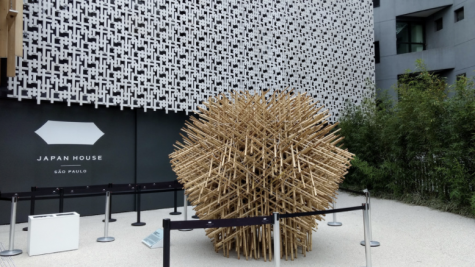A Foreign Step: House of Japan
Imagine yourself in front of a big building, hidden behind a curtain of wooden sticks that form geometric patterns clashing in vertical and horizontal directions. You have a short hour to make the most out of this experience, so you decide to take the path towards the glass front door. Of course, you accidentally walk in the pathway for handicapped people only― totally embarrassing.
When you’re finally inside, you are awed by the fact that you are in one of the only Japan Houses that exist in this world. As you look around, you suddenly feel overwhelmed because you don’t know where to start. Since the ground floor is totally packed with people who are as eager as you are to see this beautiful foreign culture, you wonder if you came at the best time to fully enjoy these precious moments.
Alright, enough with the lingering; you wander further inside the building. You have two choices now: one, head towards the alluring library, or two, walk through the exhibition of miniature versions of the architectures by Kengo Kuma, whose designs not only remain traditional but also innovative. There’s a difficult decision to make here, but you suddenly notice the food corner next to the library; guess your choice has been made for you.

Looking at the books filling the shelves of the library, you sigh in slight disappointment as you realize that you cannot buy most of the books in there, and that they’re for reference only. Yet, you regain your spirit when you remember that the entry to the museum is free, and you can come back anytime. So, you continue your walk by the shelves.
You note that there are nice sections ―food (sushi), travel, lifestyle, culture, design, technology, history, the relationship between Brazil and Japan, and children’s books― in the library which contains books in Japanese, Portuguese, and English. You pick out a book from the Culture section out of curiosity, and it happens to be Making Tea, Making Japan by Kristin Surak. Looking around for a nice spot to read, you realize that all the seats are taken. Thus, taking the book along, you walk outside into the small courtyard. It’s small but very calming, with two trees and two strangely-shaped objects made of bamboo. You sit down, open the first page of the book, then you suddenly become hyper-aware of the number of people trying to take a picture of the wooden structure right behind you.
You put the book back in its original place and walk past the food court. You pretend your stomach doesn’t growl in frustration and start heading towards the architecture exhibition. You look at all the models, curious because all of them represent different things. It’s intriguing, but your attention jumps to the woman sitting in the middle of the room wearing a kimono and performing a tea ceremony. You curiously wonder what makes this “ceremony” so special, but you soon realize that it’s an art that requires elegance and delicacy. When she finishes, you’re surprised by how captivated you were the entire time.
You suddenly notice the time and realize that you have to cover two other floors. As you rush upstairs, a small shop grabs your attention. You look at what is being sold, but remember that you have less than an hour to complete your tour.
You head to the third floor and look at the big poster. It states, in large printed letters: “Subtle – sutilezas em papel”. At that point, you don’t know what to expect and all you can see are a bunch of fragile-looking tables organized in a specific pattern. You slow down your pace and step gingerly toward the first piece of art. It’s the work of an artist named Bunpei Yorifuji, and it’s called: “Paper / Human / Paper”. In his work, he created human figures using a state-of-the-art cutting technology to constrain his work to a height of 8mm and a width of 40mm. He specifically requests, on a note set aside the table, that you look from the side angle to see how the human figures rise up and then go back into the paper. A woman beside you says something regarding the work, but you don’t understand, so you just nod with an awkward smile on your face. You then move on to the next table, and then the next, and the next, and so on. Even though you weren’t amazed by all the works of art made from all the artists, you’re very happy to have completed this exhibition.
As you start to go down the stairs, you notice the Japanese restaurant that has just opened on the third floor. You wish you could go, but you’re out of time, so you promise yourself you’ll definitely come back again.

Charlotte has always been enthusiastic in regards to writing and how it can thoroughly enrapture a passionate reader’s attention. Other than her love...








